Dark circles are an annoying cosmetic blemish that most people will face in their lives. A range of factors can lead to the formation of temporary dark circles. Such as:
- Fatigue
- Dehydration
- Allergies
- Sun overexposure
These temporary circles and eye bags can be cured with at-home remedies or rest. However, when faced with permanently formed dark circles, other options should be considered. In this blog post we will delve into what causes dark circles, how to treat them, and how to regularly maintain your lower eyelids so they don’t show up again.
Why Do I Have Dark Circles?
Puffiness of the lower eyelids is commonly caused when fat in the eye socket bulges forward. Some people have a second, smaller, puff right below the lashes. This small puff is called the orbicularis muscle, which helps the eye close.
The area of hollowness that is commonly referred to as “dark circles” is located just under the puffiness in the lower eyelid. The skin has a tight ligamentous attachment (orbicularis retaining ligament) to the underlying bone, which produces a slight indentation. This area appears dark for two reasons. First, there is a natural shadowing effect since light can’t reach the hollow area. This gives the area its dark appearance. Second, lower eyelid skin is among the thinnest on the entire body which makes it somewhat transparent. The redness of the orbicularis muscle shows through the skin. However, despite the muscle being red, it looks blue (think about how a bruise is actually from red blood but looks black and blue under the skin).
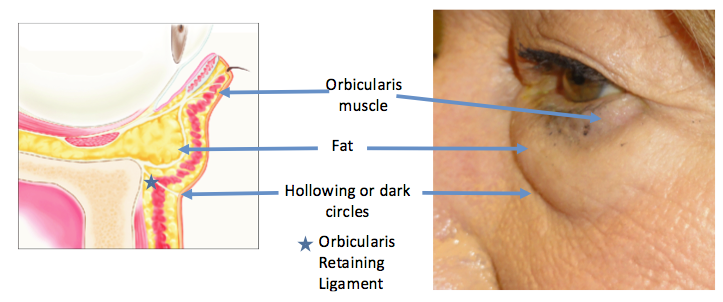
How Can I Improve The Appearance Of My Lower Eyelid?
Both surgical and non-surgical techniques exist to improve the appearance of the lower eyelids.
Non-Surgical Options
For patients who wish to avoid surgery, injecting a dermal filler, such as Restylane, into this area can improve the appearance of dark circles. We call this “filling in the hollow”. Many patients can greatly improve the appearance of this area with filler alone. Which means no surgery!
Botulinum toxin (Botox, Dysport, Xeomin) is another injectable treatment that relaxes muscles and smooths wrinkles for 3 months. These fillers can greatly improve the appearance of the eye area. When injected continually and consistently over time, deeper wrinkles will start to fade too. However, when done by an unskilled practitioner, Botox may worsen the appearance of puffy eyelids by relaxing the orbicularis muscle that holds the fat in. Our physicians are experts in the use of dermal fillers in this delicate area. You can rest assured that we will help you achieve the result you desire.
For patients who are bothered by loose skin and wrinkles, CO2 laser resurfacing can tighten skin. Laser resurfacing can also improve the appearance of dark circles by helping the skin build new collagen. This subtly works to thicken the skin so that the muscle does not become visible through the skin.
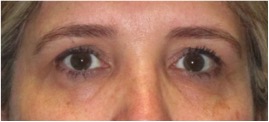
before treatment

10 days after treatment
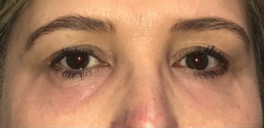
3 months after treatment. Moisturizer and sunscreen applied to lower eyelids. No make up.
This patient had Restylane (1cc total) injected into the lower eyelid hollows. She also underwent CO2 laser resurfacing on her lower eyelids to improve tightness and reduce wrinkles. She had botox injections to lift her brows and improve crow’s feet.
Surgical Options
Puffiness of the lower eyelids can be surgically removed with a lower eyelid blepharoplasty. Our oculofacial plastic surgeons perform lower eyelid blepharoplasty through the inside of the lower eyelid. By performing the surgery like this, no visible scars will be left on the skin. Removing the puffy fat also improves the appearance of dark circles by reducing the “shadow” effect.
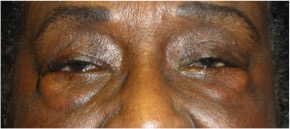
before surgery
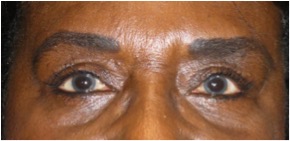
6 months after undergoing surgery
This patient underwent a lower eyelid blepharoplasty. No fat transposition or laser resurfacing were performed on the patient. The patient also underwent upper eyelid blepharoplasty and ptosis repair.
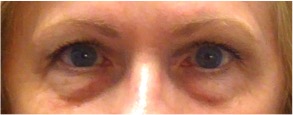
before surgery
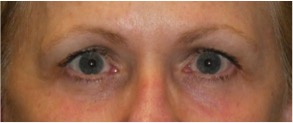
3 months after surgery
This patient also underwent lower eyelid CO2 laser resurfacing. Fat transposition was not performed in this case.
Certain patients may qualify as a candidate for fat transposition while undergoing lower eyelid blepharoplasty. This technique releases the tight orbitomalar ligament and moves some of the fat to this area to fill the hollow.
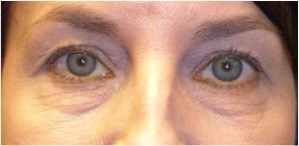
before surgery
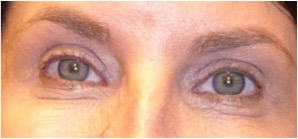
3 months after surgery
This patient underwent lower eyelid blepharoplasty (removal of fat) with lower fat transposition and lower eyelid CO2 laser resurfacing. This patient was also treated with upper eyelid blepharoplasty to improve heaviness of the upper eyelids.
How Can I Prevent Dark Circles Under My Eyes?
The skin that makes up the lower eyelid is among the thinnest and most delicate on the body. This means that the risk of it wrinkling is higher than on other, thicker-skinned, parts of your body. The risk increase stems from your skin’s natural collagen and elastin breaking down over time. The constant movement of the skin in this area from smiling facial expressions also causes wrinkles and lines.
Fortunately, there are many things that can be done to improve the appearance of the lower eyelids.
Moisturizing eye serums can temporarily improve the appearance of wrinkles by hydrating and plumping up the skin.
Sunscreen and large frame sunglasses should be utilized daily to help slow the effect that the suns harmful rays have on your face. Daily exposure to the sun can add up over the years and cause premature wrinkling and pigmentation. Use a daily sunscreen that contains zinc oxide. Zinc oxide provides excellent protection from the sun and is gentle around sensitive eyes.
Certain people may suffer from dark circles due to increased pigment (melanin) within the eye area. Daily use of sunscreen, and in some cases anti-pigmentation creams, can help improve dark circles. Your doctor can help recommend products that are safe and effective for your particular skin type.
If you have any questions or concerns about your dark circles, we provide consultations. Click the button below to schedule one.
